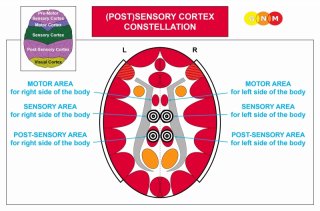(POST)SENSORY CORTEX CONSTELLATION
(POST)SENSORY CORTEX CONSTELLATION
Biological conflict: separation conflict, experienced as a loss of (physical) contact; also, wanting to separate from someone.
The (Post)Sensory Cortex Constellation manifests itself as short-term memory loss. The purpose of the short-term memory loss is to block out the memory so that the individual is better able to cope with the separation. From a biological point of view, a separation from the pack is one of the most traumatic biological conflicts. In Nature, being separated from the group usually means death. We humans share this distress with all species. NOTE: A short-term memory loss occurs already with a single SBS (Biological Special Program); with a constellation, the symptom is more evident.
The degree of the short-term memory loss is proportional to the intensity of the conflicts.
When children have a poor short-term memory, this is nowadays considered as one of the symptoms of ADD (Attention Deficit Disorder) or ADHD (Attention Deficit Hyperactivity Disorder), if the child happens to be hyperactive at the same time. From the GNM perspective, the concurrence of memory problems and hyperactivity indicates two coinciding constellations: one is related to separation conflicts, the other to conflicts of feeling stuck (see Motor Cortex Constellation). Often, the learning difficulties start after the separation from one of the parents or from both, after a move or a change of school involving a separation from schoolmates and friends, after a new sibling was born who gets more attention, after the mother goes back to work, or when the parents constantly argue or are too busy to spend time with their child. NOTE: In conventional medicine, an “ADD” diagnosis might also be made when the child is depressed (see primary depression) with poor concentration or manic-depressive with a dominance of the depressed mood; just like an “HD” (Hyperactivity Disorder) diagnosis might be made when the child is manic (see primary mania), i.e., being inattentive and easily distracted.
Separation conflicts experienced in infancy or in early childhood are the underlying cause of dyslexia.
When the elderly start to be forgetful, it is usually regarded as the first sign of Alzheimer’s disease or dementia. According to the guidelines issued in 2019 by the World Health Organization (WHO), “getting regular exercise, not smoking, avoiding harmful use of alcohol, controlling one’s weight, eating a healthy diet, and maintaining healthy blood pressure, cholesterol and blood sugar levels” apparently helps to reduce the risk of developing dementia. This claim is purely hypothetical!
Neurologists argue that Alzheimer’s is an age-related “neurodegenerative disease” that affects the functions of brain cells, whereas brain researchers argue that the memory impairment is caused by brain atrophy or enlarged ventricles. According to Dr. Hamer's findings, a brain atrophy is the result of repetitive scarring processes in the brain due to continuous conflict relapses of any biological conflict. Enlarged ventricles are linked to the choroid plexus and the distress of having difficulties memorizing (“the thoughts don’t flow smoothly”). Hence, it is not the large size of the ventricles that causes dementia, as suggested, but the other way around, namely that the short-term memory loss activates a Biological Special Program that enhances the production of cerebral spinal fluid (in the conflict-active phase) leading, eventually, to an enlargement of the ventricles (see internal hydrocephalus).
A concurrent Kidney Collecting Tubules Constellation, when abandonment/existence/refugee conflicts and separation conflicts occur together, adds confusion and disorientation to the memory loss. The result is the typical clinical picture of Alzheimer’s disease. Behavioral changes such as belligerence, social withdrawal, or depressed moods indicate further conflicts and additional constellations.
In 1986, David Snowdon, an epidemiologist at the University of Kentucky, began a research project that became known as the Nun Study (published in 2001). The goal of his investigation was to determine the causes of Alzheimer’s disease by focusing on a group of 678 Catholic sisters who are members of the School Sisters of Notre Dame congregation in Mankato, Minnesota. The participants were between 75 and 107 years of age. The homogeneous lifestyle and environment of the sisters made the nuns an ideal population to study. In addition to assessments of their medical records and regular testing of their physical and cognitive performances, the participants agreed to donate their brain after death for research purposes. The outcome was remarkable! The postmortem examination of the nun’s brains revealed that a significant number were showing pathologies of Alzheimer’s in their brain, even though the sisters never exhibited signs of memory loss during life. Researchers in the field of brain plasticity suggested that the nuns’ mental activities favored the development of new neural networks that eventually assumed the work of the degenerated brain cells. The science of GNM takes a different approach. Based on the findings that every disease is caused by a biological conflict (First Biological Law), the memory decline, as seen in Alzheimer’s patients, does not originate in the brain but instead in the psyche, precisely, from lasting separation conflicts leading over time to dementia. Hence, the “plaques” found in the brain are not the cause of the memory loss but the result of continuous repair processes in the conflict-related brain relays. If the person manages to resolve the separation conflicts, the memory function returns to normal, the plaques, however, remain. This explains why there are people, like some of the Notre Dame’s sisters, who had “pathologies” of Alzheimer’s in their brain while their memory was fully intact. The Nuns Study also confirms the GNM understanding that memory problems are entirely unrelated to aging.
|




